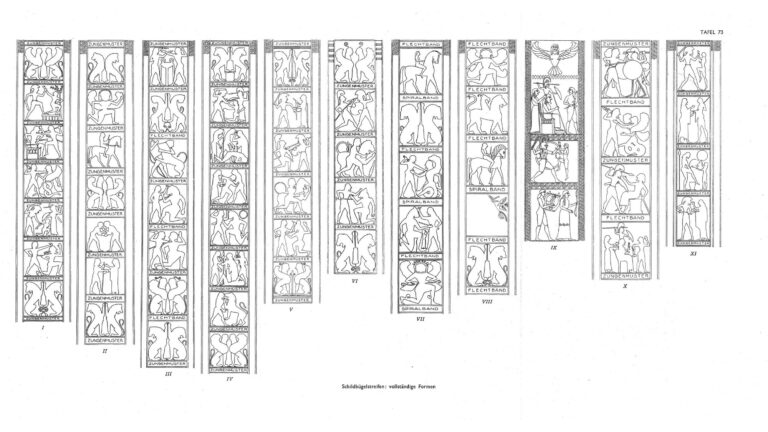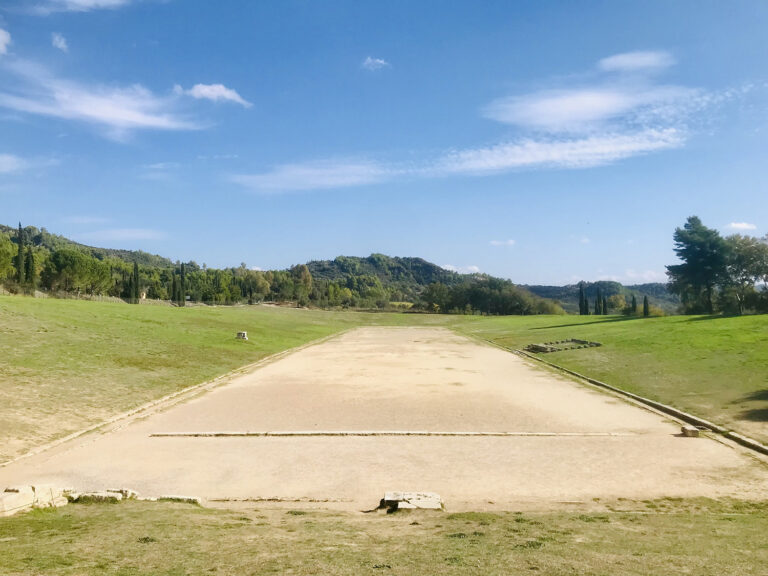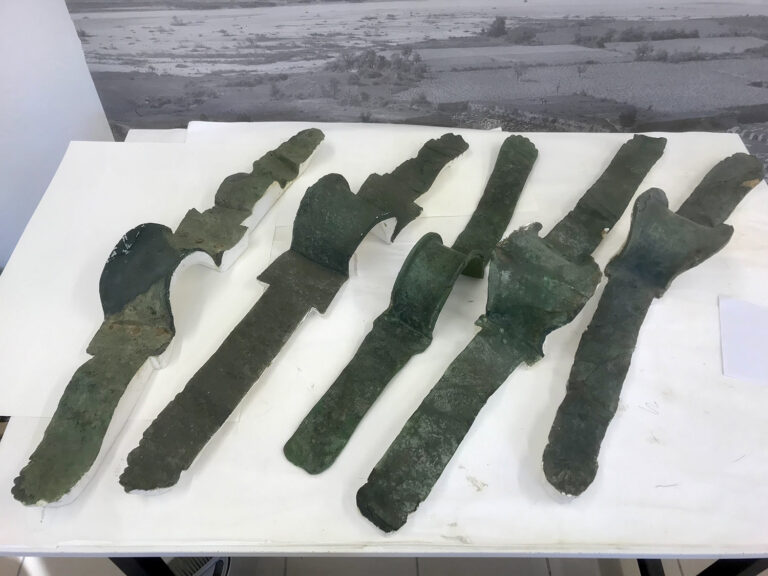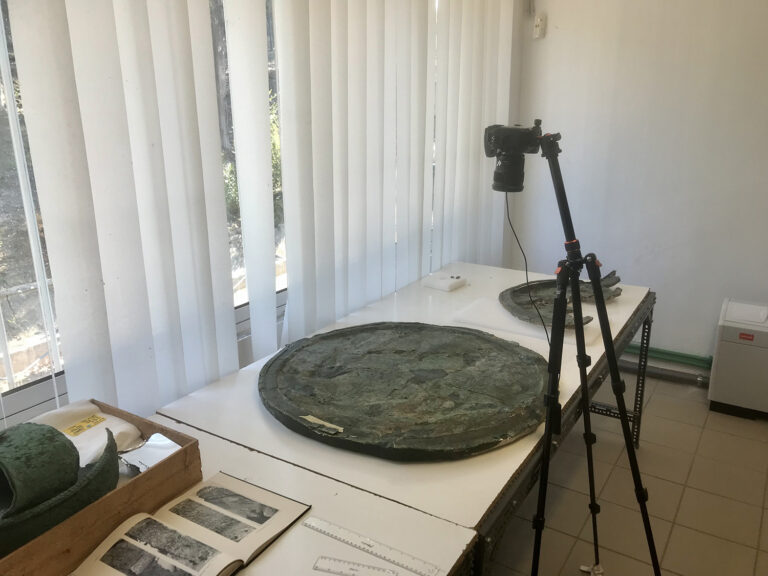About
The Gdańsk Decorated Armour Database showcases a unique body of material culture: decorated hoplite shield-bands (ochano aspidas) produced in the Peloponnese between the mid-seventh and early-fifth centuries BC (ca. 650–450 BC). A shield-band was a bronze strip which ran over the inside of a hoplite’s shield. It was attached with small pins to the shield’s rim and the central arm-band (porpax) through which a warrior thrust his left arm to hold the shield in place. The practical use of the shield-bands is not entirely clear; their function could have been to reinforce the porpax – the essential part of the shield’s unique grip system – but images of shields on Greek vases indicate that shield-bands were not an essential component but rather an optional feature of the shield, an elaborate add-on item commissioned by wealthy warriors who wanted to personalise their military gear.
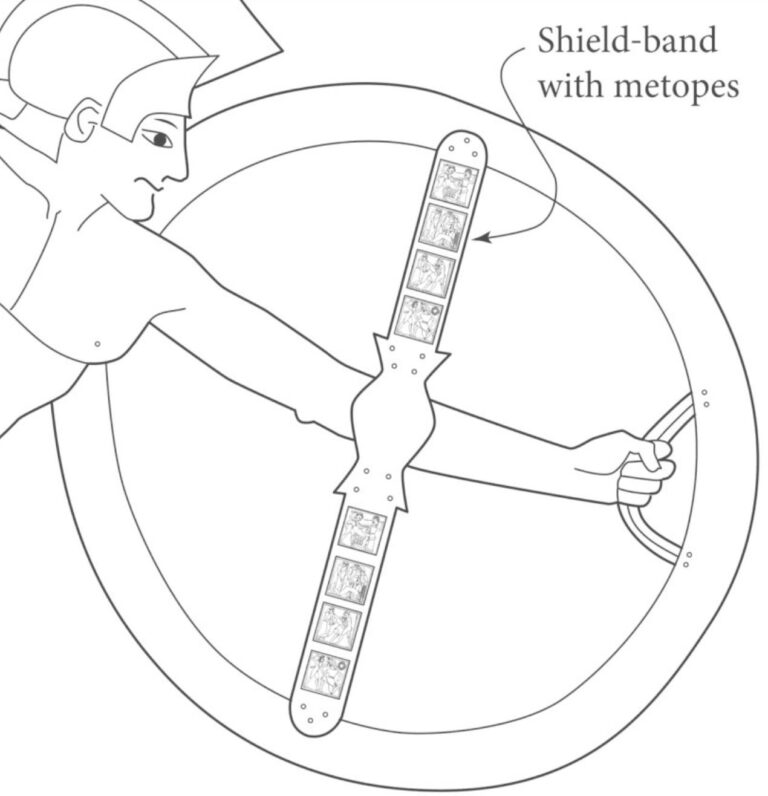
The imagery depicted on the shield-bands reflects the richness of the Greek art of the Archaic era (ca. 800–450 BC). Most bands include scenes of animals (lions, panthers) and fantastic creatures, such as the Gorgons or the sphinxes – widely believed by the Greeks to have apotropaic qualities (having the power to avert evil and bad luck). Many images were drawn from the enormously rich world of Greek mythology, in particular from the exploits of legendary heroes, such as the Labours of Heracles or Theseus fighting the Minotaur, or the lives of the Olympic gods (e.g. Zeus fighting Typhon, the birth of Athena). Some feature episodes from the Trojan War (e.g. the abduction of Helen, the rape of Cassandra, Ajax’s suicide, the death of Priam), while others show more generic scenes drawn from the everyday life of warriors, including horse-riding, arming, wrestling or departures from home. The sheer variety of scenes strongly suggests that the warriors had some choice in selecting the images they wanted to feature on their shield-bands. The small size of the metopes (5–7 cm in width), and their peculiar placement on the inside of the shield, also imply that the bands were not meant for display; being visible only to the warrior holding the shield, the shield-bands were therefore items of high personal value, in turn making them a unique historical source of images which accompanied Greek warriors to battle.
Based on their production technique and artistic imagery, the shield-bands were almost certainly developed in the metal workshops in the city of Argos, not long after the first appearance of hoplite shields on the Greek mainland (ca. 700 BC). Although Argos remained the main centre of shield-band production throughout the Archaic era, making the bands primarily a Peloponnesian phenomenon, their popularity extended far beyond southern Greece, with examples found in central and northern Greece, Italy, Cyprus and modern-day Turkey (Baitinger 2011). The majority of surviving shield-bands come almost exclusively from local and Pan-Hellenic sanctuaries, such as the Temple of Zeus at Olympia, the Temple of Poseidon on the Isthmus of Corinth, or the Temple of Apollo at Delphi, where Greek city-states (poleis) dedicated captured weapons and armour after victorious battles as a thanksgiving to the gods. Often inscribed with the name of the victors and the defeated, such trophies would then be displayed in the sanctuaries for all visitors to see and admire, advertising the military strength of the dedicating poleis.
The ancient site which produced by far the most examples of shield-bands was the sanctuary of Zeus at Olympia (modern Archaia Olympia), the major centre for dedicating armour in the Greek world, most famous in antiquity for hosting the Olympic games. Studied since 1875 by the German Archaeological Institute, the excavations at Olympia have unearthed an unparalleled collection of ancient arms and armour, including over 900 spearheads, 500 helmets, 460 arrowheads, 300 greaves and 200 shields. The sheer number of weapons and armour dedicated at Olympia meant that after being displayed for a certain amount of time, most weapons had to be disposed of (e.g. thrown in wells) or, in the case of hoplite shields, be re-used for other purposes, for instance as filling-material for the banks of earth around the athletic stadium on which the spectators sat. Buried deep in the ground, such shields have been unearthed by modern excavators and survived in often excellent condition.
Decorated shield-bands, found mostly in the area around the north and south stadium walls at Olympia, have been published, with images and drawings, in the excavation reports called Olympische Forschungen (OF), first by Emil Kunze in 1950 (Band II), supplemented by Peter Bol in 1989 (Band XVII); both Kunze’s and Bol’s record and sequence numbers are indicated in the database with an OF prefix. The dating and decoration description of each shield-band in the database follows the information from Kunze and Bol, unless otherwise indicated. The majority of the images stored in the database were taken in November 2022 in the Archaeological Museum of Olympia and the Museum of Ancient Olympic Games in Archaia Olympia. The additional images from Kunze’s OFII volume have been kindly provided by the German Archaeological Institute – Athens. Drawings of individual shield-bands were made by Steve K. Simons and Natalia Kozłowska.
DECORATED PELOPONNESIAN SHIELD-BANDS - Hoplite stories
DOWNLOAD article
Further reading:
Baitinger, H. (2011), Waffenweihungen in griechischen Heiligtümern, Mainz.
Barringer, J. (2021), Olympia: A Cultural History, Princeton.
Bol, P. (1989), Argivische Schilde (Olympische Forschungen Band XVII), Berlin.
Carpenter, T. H. (2015), “The Trojan War in early Greek art”, in M. Fantuzzi & C. Tsagalis (eds), The Greek Epic Cycle and its Ancient Reception, Cambridge, pp. 178–195.
Chalazontitis, I., Koukouli-Chrysanthaki, C. and Malamidou, D. (2018), “EΝΤΟΣ AΜΩΜΗΤΟΝ: An Argive-type Shield from the Sanctuary of Oisyme”, The Annual of the British School at Athens 113, pp. 199–219.
Jackson, A. H. (1991), “Hoplites and the Gods: The Dedication of Captured Arms and Armour”, in V. D. Hanson (ed.), Hoplites: The Classical Greek Battle Experience, Abingdon, pp. 228–249.
Kucewicz, C. (2025), “Hoplite Stories: Decorated Peloponnesian Shield-bands”, Ancient Warfare 101, pp. 8–11.
Kunze, E. (1950), Archaische Schildbänder (Olympische Forschungen Band II), Berlin.
Schwartz, A. (2013), Reinstating the Hoplite: Arms, Armour and Phalanx Fighting in Archaic and Classical Greece, Stuttgart.
Snodgrass, A. M. (1999), Arms and Armor of the Greeks, London.
Van Wees, H. (2004), Greek Warfare: Myths and Realities, London.
